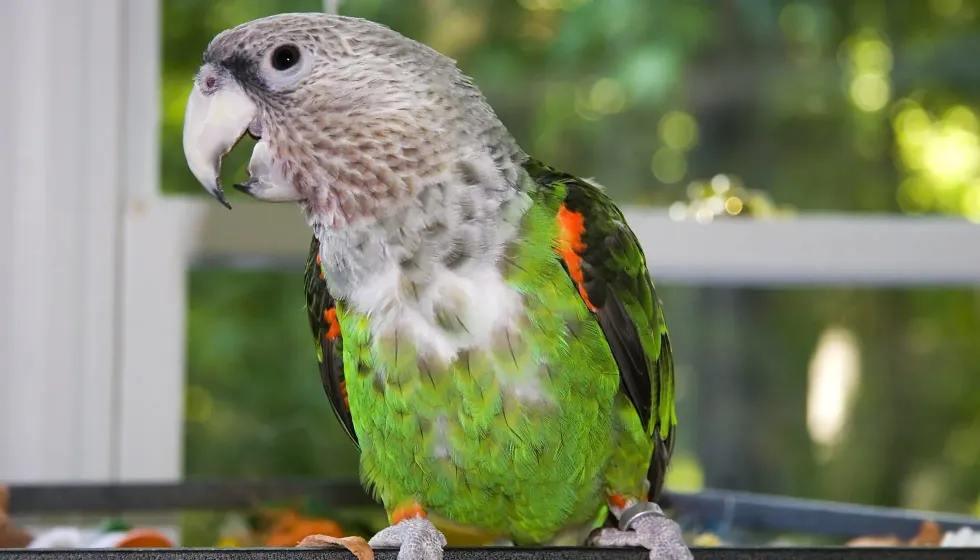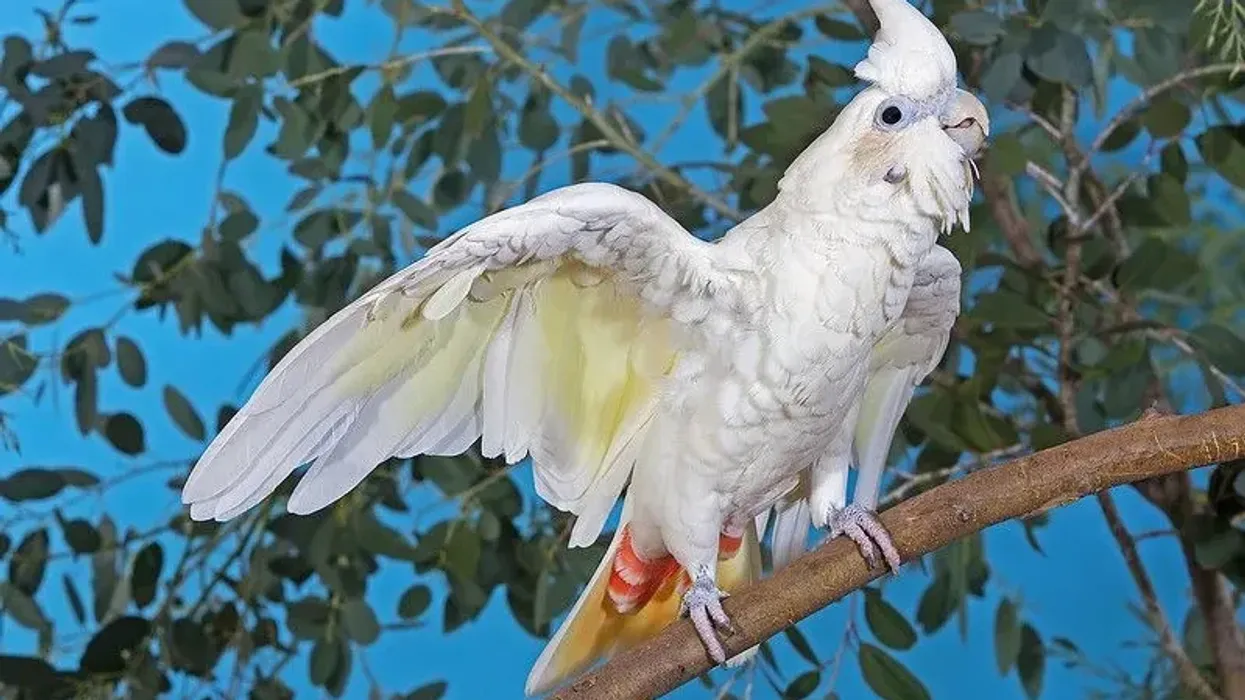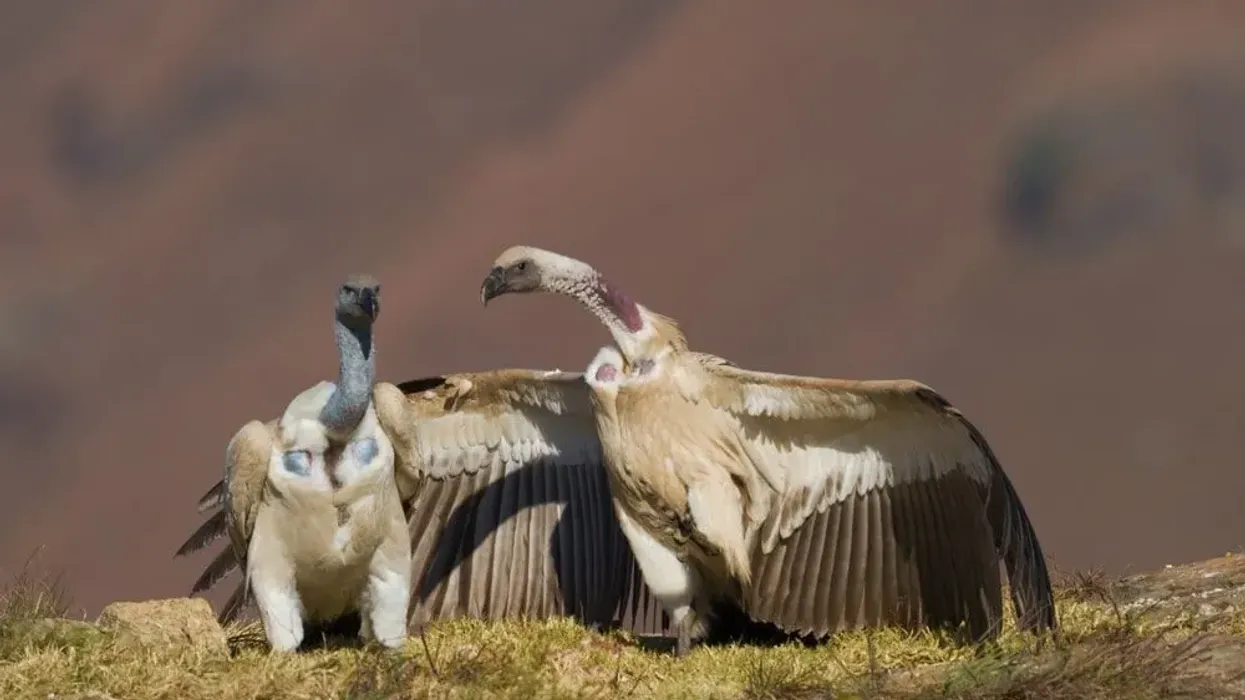Residing in the forests of Yellowwood, South Africa, the Cape parrot (Poicephalus robustus), also called Levaillant’s Parrot, is a one of a kind species of parrots from the genus Poicephalus found in the world. It is considered the largest parrot of the African Poicephalus genus of parrots.
This gray-headed parrot is restricted to the forests of Africa exclusively.
A tourist taking a tour in the jungles of Cape Town may spot these cute creatures peeking through holes in a tree. Parrots are fun, intelligent, loud birds that are also social and can whistle like us, humans!
The owners of Cape parrots usually report that these creatures make a variety of loud noises and have one-of-a-kind whistles.
This rare breed is similar to the other breeds such as the African gray parrot and Senegal parrot found in similar habitats is now officially regarded as an entirely separate species. Below mentioned are a few facts about these cute creatures that may make a person fall in love with these wild yet loving birds.
Afterward, do check our other articles on the green parakeet and the king vulture as well.
Cape Parrot Interesting Facts
What type of animal is a Cape parrot?
Cape parrot (Poicephalus robustus) is a wild South African bird. These fruit-eating birds are beautiful when seen and have a variety of colors on their body.
Even though this brown-necked parrot species is rare they make great pets according to pet owners.
African authorities under the Cape Parrot Project are trying their best to save these innocent creatures from extinction. Cape parrots that are held captive by the owners learn to mimic the sound that they are exposed the most to and they also learn to mimic their owners’ sound.
What class of animal does a Cape parrot belong to?
A Cape parrot (Poicephalus robustus) is a bird and belongs to class Aves because of its ability to fly and lay eggs. The gray-headed parrot also has a pair of wings that are made of dark olive green feathers.
These features help them camouflage on the tree branches and in the bark cavities of the tree. It is now official that Poicephalus robustus is a separate species.
How many Cape parrots are there in the world?
Unfortunately, these birds are declining in number. They are only found in South Africa and are in the process of being saved by South African authorities.
In the southern mist belt forests of South Africa, there are fewer than 2000 Cape parrots left. These birds fall under the category of Africa’s most endangered species of animals and are fighting hard for survival.
Where does a Cape parrot live?
The Cape parrot is found in the wild jungles of the Afromontane southern mist belt forests of South Africa across Eastern Cape, Kwazulu Natal, and Limpopo Province. In these forests, they usually make their nests in yellowwood trees which are found in patches across southern and eastern South Africa.
Various species of yellowwood tree include Podocarpus latifolius, Podocarpus falcatus, and Podocarpus henkelii. Also in these trees, they reside at an altitude of 3,300-5,000 ft (1006-1524 m).
What is a Cape parrot's habitat?
The Cape parrot usually lives in the confinements of the forests and doesn’t migrate until summer when there is a scarcity of food. To make up for scarce food, they travel up to coastal forests and commercial orchards to find food which usually includes commercial crops such as pecan nuts.
The yellowwood trees are the most important for their survival since these birds have evolved and adapted to live in the niches made of these trees. Here they breed, nestle, feed, and interact with the birds of the other species residing in the same area.
Who do Cape parrots live with?
This brown-necked parrot usually stays in large flocks. These flocks consist of the members of their own family and non-breeding birds. The size of the flock can go up to 20-70 birds. This happens because several bird groups come together during their fight.
How long does a Cape parrot live?
The Cape parrot's lifespan is considerably longer than other species of the family. The ones that are held captive can live up to 30 years. At the age of three to four years, they start breeding and give birth to three to four chicks at a time.
Their survival rate in the wild and captivity is usually the same. Perhaps it is seen that these birds survive better in captivity if a proper and healthy environment is administered. In the wild, they survive well in the snags or yellowwoods.
How do they reproduce?
The Cape parrot breeds all around the year. At a time the female lays around four round glossy eggs out of which at least two survive.
Both the parents are involved in looking after their babies but the mother parrot spends more time in the nest. The incubation period is of about 28-30 days and the chicks fledge in 10-12 weeks. After they stay around their parents and are fed by them until they are grown enough to breed on their own.
What is their conservation status?
Only about 400 of these are spotted in the wild, raising concerns about their extinction. A lot of efforts are being put in by the African Cape Parrot Project where they aim to save these birds from extinction. This is one reason there’s a ban on selling and buying these exotic birds.
Cape Parrot Fun Facts
What do Cape parrots look like?

*Please note that this is an image of a Meyer's parrot, not a Cape parrot specifically. If you have an image of a Cape parrot, then please let us know at hello@kidadl.com.
This is one colorful bird with a golden olive head and hard brown beak. The color on its neck is dark brown matching the color of its eyes.
Their wings are dark green in color and their underside has a tint of blue. The color of their thighs is red-orange and females have a crown that is also red-orange in color.
How cute are they?
Just like any other parrot species, the Cape parrot is a beautiful, colorful, loud, and social bird. Cape parrots are very cute and appealing in appearance and hence it is one reason why a lot of people want them as pets.
How do they communicate?
Parrots are very smart birds and are fast in understanding sounds. They catch the regular sounds in their niche and are able to mimic them. They are more fun when they mimic the sounds of their owners. These birds also have a peculiar mating call that enables them to find a partner for mating.
How big is a Cape parrot?
Cape parrot is one of the largest African parrots present at the moment. It can grow twice as large as normal green parrots and measure around 13 in (33.02 cm) long.
While kea parrots are one of the smallest parrots, hyacinth macaws are considered the largest flying parrot species in the whole wide world with a length of 39.4 in (100 cm).
How fast can a Cape parrot fly?
The Cape parrot is a good flyer. They usually fly between coastal forests and island forests for their foraging activities. They can travel a distance of about 55-60 miles (89-97 km) in a day.
How much does a Cape parrot weigh?
Since the Cape parrot is a large bird, it is slightly heavy in weight in comparison to urban birds. The weight of an adult Cape parrot can go up to 10-14 oz (0.28-0.39 kg).
What are the male and female names of the species?
There are no sex-specific names for Cape parrots. Female Cape parrots have a special feature that is absent in males. This feature is a crown, the color of which is red and orange, which is like a patch on the forehead. A crown enables to differentiate between male and female Cape parrots visually.
What would you call a baby Cape parrot?
A baby Cape parrot is called a chick and weighs between 4.2-4.9 oz (0.12-0.14 kg). Since Cape parrots are social birds the chicks live with their parents for a good amount of time after birth.
They learn how to fly and survive from their parents and stay in a flock with the other adult parrots. An adult Cape parrot feeds their baby chick with the same food that it eats.
These may include seeds, worms, and kernels from various fruits. This helps the chick grow stronger and, in turn, increases their survival rate.
What do they eat?
The Cape parrot is an omnivorous bird. It has a really strong beak that enables it to break through hard kernels of fruits. It mostly prefers fruit kernels of yellowwood trees, but in the absence of these, it can even feed on plums, pine seeds, cherries, and eucalyptus flowers.
Are they dangerous?
These birds are completely harmless and would only harm someone under very special circumstances. Even though these creatures are said to have very tough beaks that make the process of feeding easier for them, they do not harm humans with it.
Would they make a good pet?
These birds make great pets and are owned by people in a lot of places. People pet these colorful social birds and usually feed them with plum, pine seeds, cherries, and eucalyptus flowers.
Since the parrot learns easily, the owner can teach them a few words and make them smarter. It is really cool to have them as pets if you can afford the Cape parrot price.
Did you know...
Cape parrots are seed predators and with the help of their very strong beak, this species able to exploit food before other frugivores. These birds can even feed on unripe fruit which others are not able to do.
These birds are very demanding and hence owners have to spend extra time and money on them.
If these birds are exposed to poor diet and hygiene, this species may suffer from diseases such as calcium deficiency, psittacine beak, and feather diseases. This species is also prone to fungal, bacterial, and viral infections if they are not taken care of properly.
Getting your own Cape parrot
Even though their trading is considered illegal since they are an endangered species, they are bought quite frequently. The Cape parrot price ranges from $3,000 to $3,500. One reason why they are very expensive is that they are rare and are only found in South Africa.
Comparisons with similar parrots
The bigger size and presence of a curved beak is a peculiar feature of a Cape parrot. On the forehead of female Cape parrots, there is a presence of an orange patch which is absent in other parrot species. This feature also enables a person to distinguish between male and female Cape parrots.
The only way to distinguish between the Cape parrot and gray-headed parrot is the distinct color of the head and neck as well as the different sizes.
There are some subtle differences between a Cape parrot and a brown parrot, despite their similar appearance. The Cape parrot has a bigger head and beak compared to the brown parrot.
Here at Kidadl, we have carefully created lots of interesting family-friendly animal facts for everyone to discover! Learn more about some other birds from our rhinoceros hornbill facts and boreal chickadee facts pages.
You can even occupy yourself at home by coloring in one of our cape parrot coloring pages.










